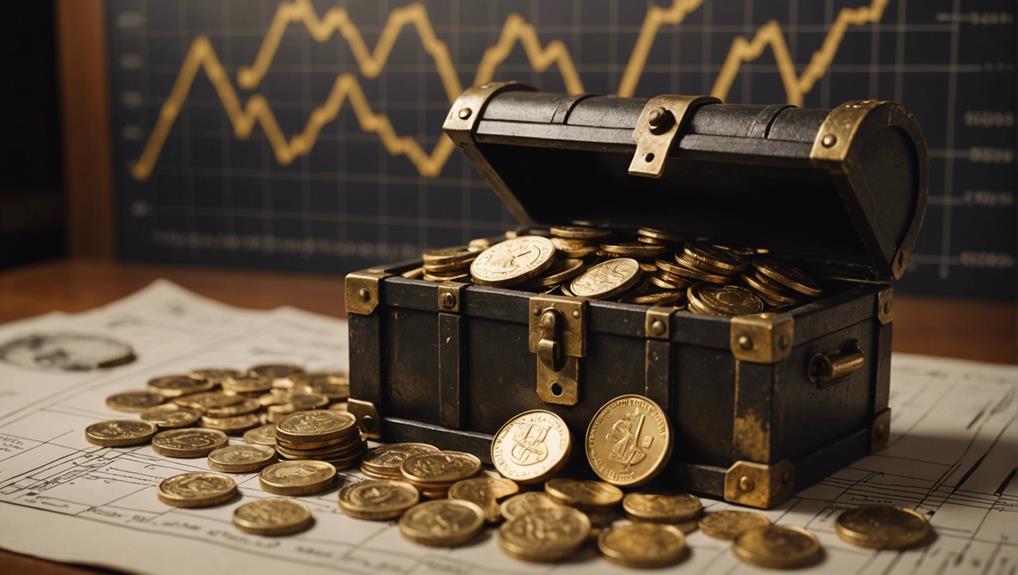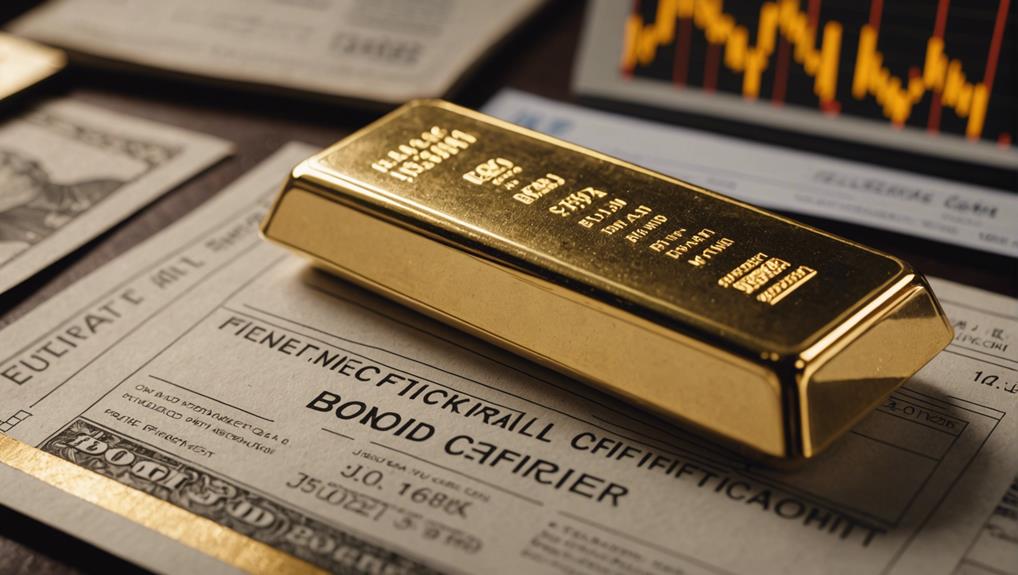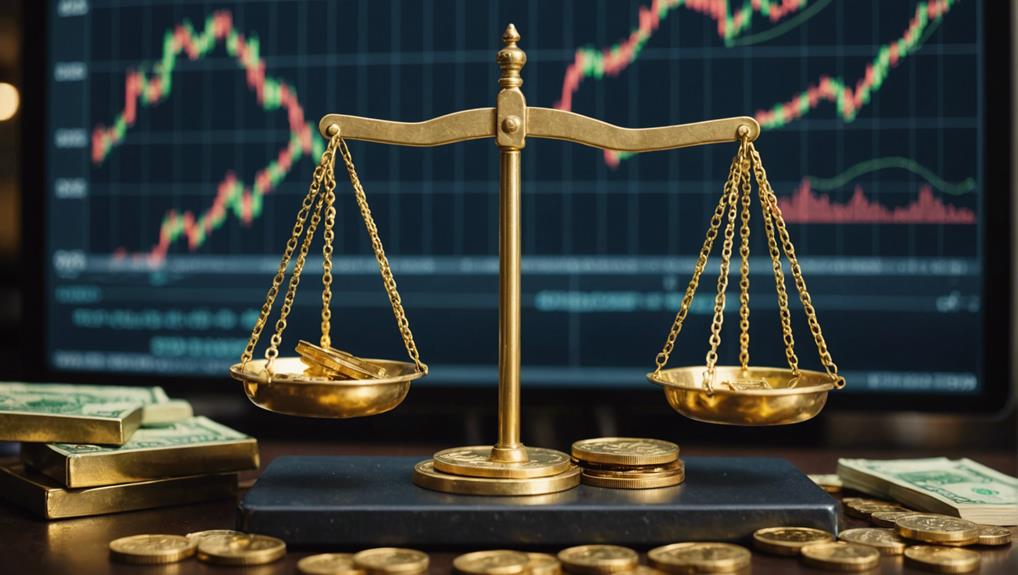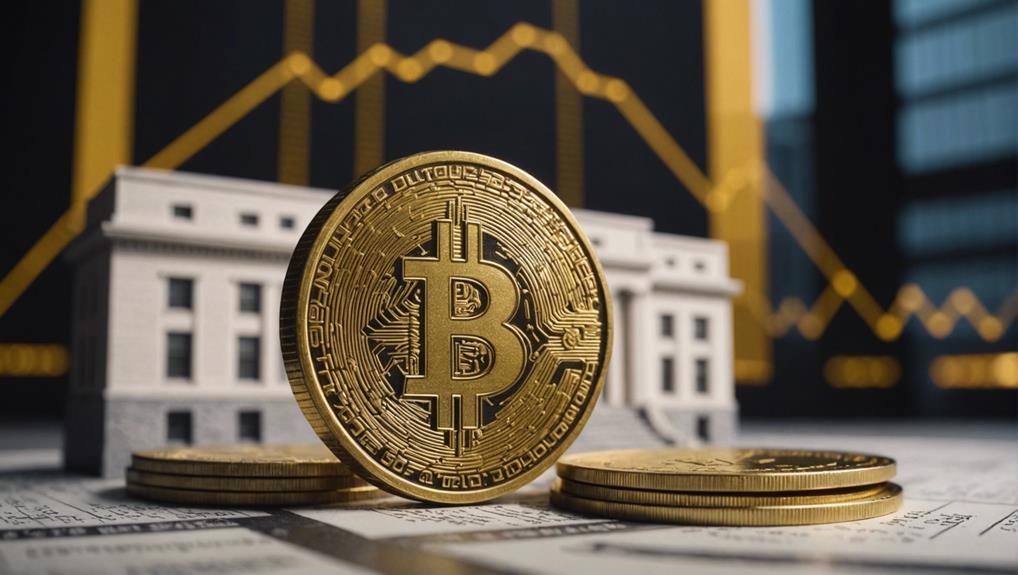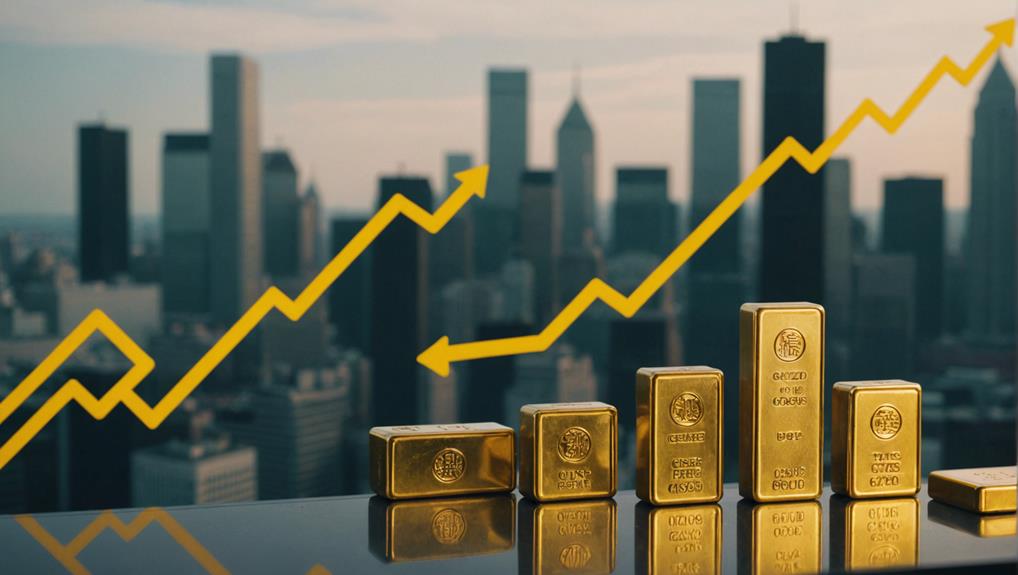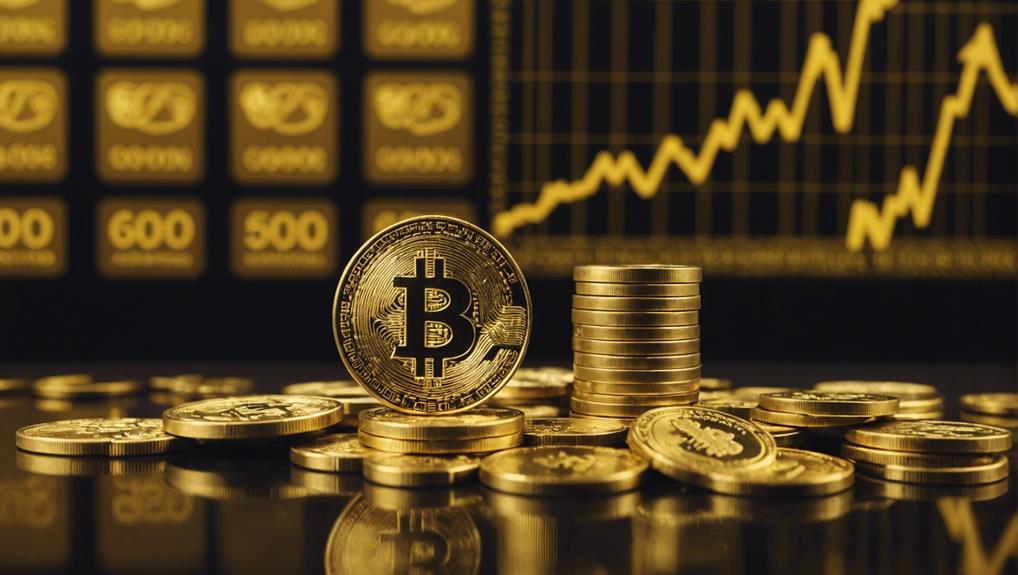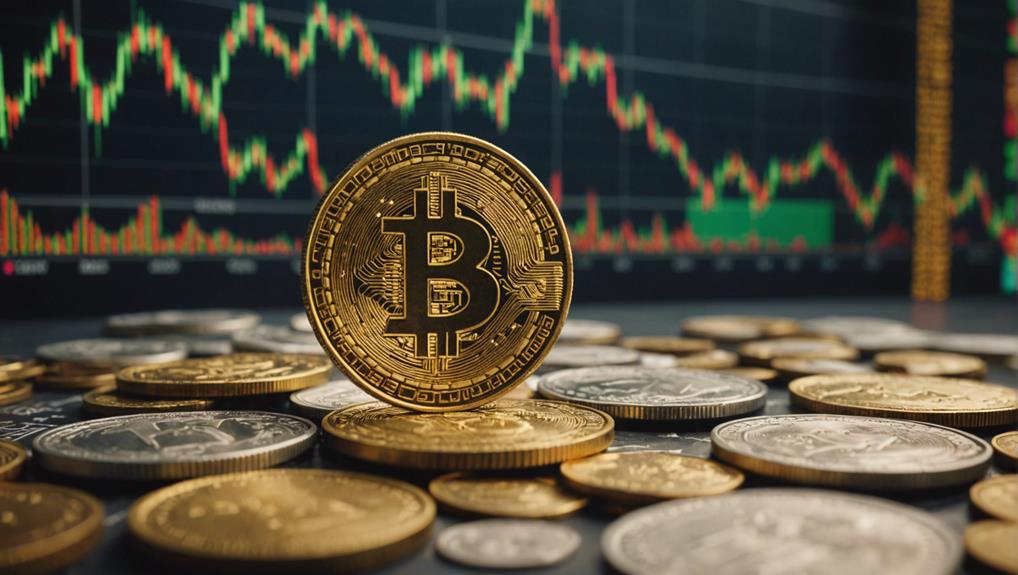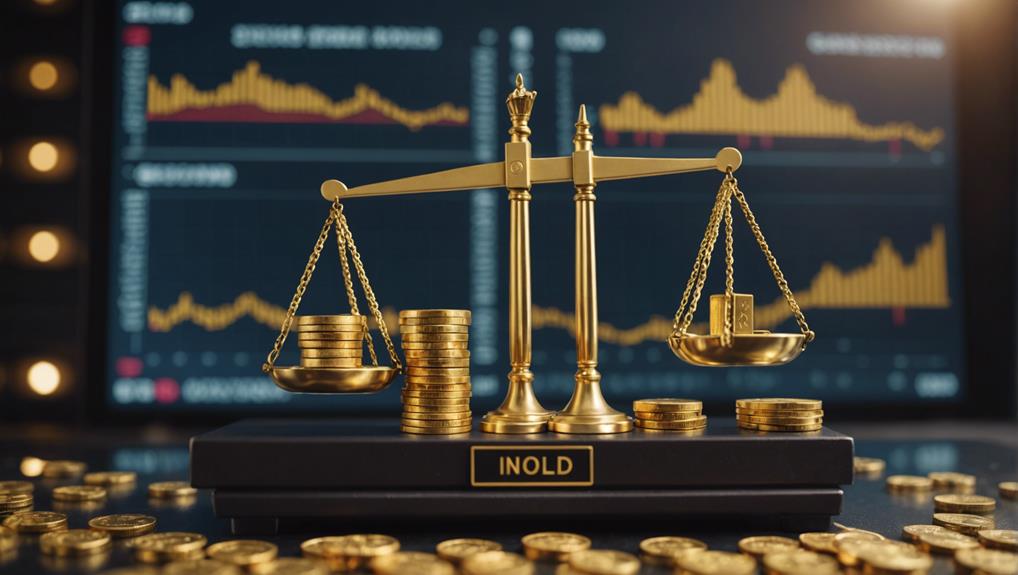When you consider investing during periods of inflation, gold stands out as a historically reliable option. It’s consistently acted as a hedge, preserving wealth when other assets suffer due to rising prices. Throughout history, when inflation rates climb, gold’s demand typically increases, reinforcing its value. Unlike volatile stocks or depreciating bonds in inflationary times, gold maintains or even enhances its worth. This stability derives from gold’s intrinsic value and limited supply—a result of constrained mining activities. Including gold in your investment portfolio might offer the financial security you seek during uncertain economic conditions. Further investigation could offer a deeper understanding of this asset’s enduring resilience.
Historical Analysis of Gold
Throughout history, gold has consistently maintained its value, serving as a reliable hedge against inflation. You’ve seen it remain a symbol of wealth and security across various civilizations, from the ancient Egyptians to modern nations. Gold’s allure isn’t merely in its beauty or rarity; its practical applications in electronics and aerospace further cement its value.
Unlike paper currencies which governments can print at will, gold’s supply is limited by mining, which can’t quickly adjust to spikes in demand. This scarcity, combined with its universal acceptance, ensures that gold’s purchasing power remains remarkably stable over time.
It’s not merely an old relic; it’s a critical asset in any well-rounded investment portfolio, offering a safety net when other assets might falter.
Inflation Impact on Asset Values
As inflation rates rise, you’ll notice that not only gold but other asset values tend to fluctuate significantly. This variability can impact your investment portfolio, particularly if you’re holding commodities or real estate.
Understanding how inflation influences these assets is vital for making informed decisions about where to allocate your resources.
Inflation Rates Influence Gold
Inflation often drives investors to gold, seeing it as a stable store of value during economic uncertainty. As prices rise and the purchasing power of currency falls, you’ll find that gold often behaves differently than other assets. Here’s how:
- Preservation of Wealth: Unlike paper money, gold retains intrinsic value, making it a favored choice when you’re worried about inflation eroding your savings.
- Hedge Effectiveness: Historically, gold prices have risen when inflation increases, providing a hedge against the diminishing value of fiat currencies.
- Demand Surge: During high inflation periods, the demand for gold increases as both individual and institutional investors seek safety.
This trend reinforces gold’s role as a reliable asset in volatile economic conditions.
Asset Value Fluctuations
While gold often maintains its value during inflation, other assets can experience significant fluctuations in worth. You’ll find that real estate, stocks, and bonds react differently under inflationary pressures.
For instance, real estate might appreciate if the demand remains strong despite rising prices, offering you a potential hedge against inflation. Conversely, stocks can be volatile, with their value influenced by company performance and investor sentiment, which inflation can negatively affect.
Bonds generally lose appeal because inflation erodes the real return on fixed-income investments. It’s important you diversify your portfolio to mitigate risks associated with inflation. Understanding how each asset class responds to inflation helps you make informed decisions, ensuring your investments are better protected.
Gold Versus Stocks During Inflation
During periods of inflation, gold often outperforms stocks as a more stable investment. You might find this interesting because it means you’re less likely to see dramatic losses when the economy gets shaky. Here’s why gold tends to shine:
- Inherent Value: Gold has intrinsic value due to its limited supply and broad acceptance as a store of value.
- Less Volatility: Unlike stocks, gold isn’t tied to corporate earnings or management decisions, which can fluctuate wildly in uncertain economic times.
- Hedge Against Inflation: As a tangible asset, gold often appreciates when the purchasing power of fiat currency declines.
Gold’s Behavior in Economic Crises
Gold’s resilience becomes particularly evident as it often maintains or increases its value in times of economic crises. When you look at historical data, you’ll find that during significant downturns, such as the 2008 financial crisis or the economic instability caused by the COVID-19 pandemic, gold not only held its ground but also experienced substantial gains.
This behavior can be attributed to gold’s status as a ‘safe haven’ asset. Investors flock to gold when confidence in other markets wanes, believing it to be a secure store of value. This increased demand pushes its price up, contrasting with more volatile assets like stocks, which typically suffer during such times.
In turbulent times, gold proves to be a reliable investment.
Methodologies in Gold Valuation Research
Exploring various methodologies in gold valuation research helps you understand how experts estimate its market price under different economic conditions. Analysts typically use a blend of quantitative and qualitative approaches to predict gold’s worth:
- Historical Data Analysis: Researchers sift through decades of gold price records, identifying patterns and correlations with global economic indicators.
- Supply and Demand Dynamics: You’ll see studies focusing on mine production rates, recycling processes, and consumer demand across industries.
- Macroeconomic Models: Experts incorporate variables like inflation rates, currency values, and interest rates to forecast gold prices in different scenarios.
These methodologies provide a robust framework for understanding gold’s behavior, ensuring that you’re well-equipped to discuss its role as an inflation hedge.
Case Studies of Inflation Periods
As you investigate the domain of inflation and its impacts, it’s imperative to examine how gold has historically held up during these periods.
You’ll see that gold performance metrics often contrast sharply with other assets, which react differently under the same economic pressures.
Historical Inflation Impact Analysis
Throughout history, several inflation periods have demonstrated gold’s ability to retain its value. Here are notable examples:
- The Great Inflation (1970s, USA): During this time, as prices skyrocketed, gold’s price rose dramatically, standing out as a pivotal asset amid economic uncertainty.
- Hyperinflation in Zimbabwe (2000s): With the Zimbabwean dollar plunging in value, gold became a vital means of preserving wealth, showcasing its reliability.
- Weimar Republic Hyperinflation (1920s, Germany): As the mark became practically worthless, gold remained a consistent store of value, helping people weather the economic storm.
These instances highlight how gold not only holds its value but can be a safe haven during turbulent economic times.
Gold Performance Metrics
Building on these historical examples, let’s examine specific metrics that quantify how effectively gold has performed as a hedge against inflation in various periods.
You’ll see that during the high inflation years of the 1970s, gold’s price increased at an average annual rate that significantly outstripped the general inflation rate. For instance, between 1970 and 1980, while the Consumer Price Index (CPI) roughly doubled, the price of gold increased by an average of 14% per year.
Similarly, during the 2008 financial crisis, despite initial declines, gold quickly rebounded, its value rising as confidence in traditional financial systems waned.
This resilience underlines gold’s role in preserving wealth during volatile economic times.
Comparative Asset Behavior
Let’s now compare gold’s performance to other assets during inflationary periods, using specific case studies for clarity.
- Stocks: During the high inflation of the 1970s, the stock market experienced significant volatility. While stocks generally offer growth potential, they can suffer during inflation spikes as corporate profits get squeezed.
- Real Estate: Often considered a good hedge against inflation, real estate values tend to rise as prices increase. Yet, during sudden inflation surges, the property market mightn’t adjust quickly enough, leading to short-term losses.
- Bonds: Typically, bonds perform poorly in inflationary environments as rising interest rates lead to falling bond prices. They’re less attractive when inflation diminishes the real return on fixed interest payments.
In these scenarios, gold often maintains or increases its value, providing a reliable store of wealth.
Comparative Analysis With Bonds
When comparing gold and bonds, it’s important to note that gold often maintains its value better during periods of high inflation. You’ll find that while bonds provide fixed returns, these can be eroded by increasing prices. Gold, on the other hand, typically rises in value when inflation climbs, serving as a hedge against the decreasing purchasing power of currency.
Here’s a quick overview to help you understand their performance in varying economic conditions:
| Aspect |
Gold |
Bonds |
| Value in Inflation |
Often increases |
May decrease |
| Liquidity |
High |
Moderate |
| Risk |
Moderate |
Low to moderate |
This comparison should help you weigh which asset might better suit your investment strategy during inflationary times.
Predictive Models for Gold Prices
Understanding predictive models for gold prices can empower you to forecast future market trends effectively. These models incorporate various factors, allowing you to comprehend how different variables may impact gold’s price movement.
Here are three crucial elements typically used in these models:
- Historical Price Data: By analyzing past price trends, you can identify patterns that might repeat under similar conditions.
- Global Economic Indicators: Economic health indicators, such as GDP growth rates and unemployment figures, influence investor behavior and gold prices.
- Supply and Demand Dynamics: Changes in mining output or shifts in jewelry and technology sector demands directly affect gold’s market price.
Impact of Monetary Policies
Monetary policies significantly influence gold prices as central banks adjust interest rates and money supply to manage economic stability. When interest rates drop, traditional savings offer lower returns, prompting you to seek alternative investments like gold, which doesn’t yield interest but can appreciate in value. Conversely, when rates rise, gold may seem less appealing since other assets might offer higher yields.
Central banks additionally impact gold prices through their reserves. Buying or selling significant amounts of gold can adjust its global market price. As you monitor these trends, you’ll notice that during times of monetary expansion, when more money is introduced into the economy, gold often becomes a go-to asset, seen as a hedge against potential inflation and currency devaluation.
Investment Strategies in Inflationary Times
As you make your way through inflationary times, it’s essential to consider how diversifying your asset portfolio can help protect your investments.
Exploring the benefits of real estate investment might provide a hedge against inflation’s erosive effects on currency value.
Furthermore, understanding the differences between bonds and stocks will provide you with better decision-making tools for your investment strategy.
Diversifying Asset Portfolios
To protect your investments from inflation, consider expanding your asset portfolio with a mix of stocks, bonds, and precious metals like gold. This approach helps you manage risks and optimize returns, even when the market’s unpredictable.
Here’s what you’ll achieve by diversifying:
- Stability: Bonds offer steady income, buffering against volatile market fluctuations.
- Growth Potential: Stocks can provide significant returns, capitalizing on economic growth.
- Inflation Hedge: Gold maintains its value over time, serving as a secure haven during economic uncertainty.
Real Estate Investment Benefits
Shifting focus to another robust investment strategy, real estate offers several advantages during inflationary periods. As inflation rises, property values and rents typically increase, providing you with potential capital appreciation and increased rental income. This isn’t only about making more money; it’s about preserving your purchasing power when currency value dips.
Real estate can act as a hedge against inflation, as these tangible assets often react positively to economic shifts that erode the value of cash savings. Moreover, if you’re leveraging your investments with fixed-rate mortgages, your debt becomes cheaper to service over time due to inflation’s impact on money’s value.
Wisely chosen real estate investments can offer you both stability and growth during uncertain economic times.
Bonds Versus Stocks Analysis
Let’s compare bonds and stocks to understand which might serve you better as an investment strategy during inflationary times. Bonds are generally considered safer investments; they provide fixed income returns that can be predictable. Yet, during periods of high inflation, the fixed returns from bonds may not keep up with the rising cost of living. On the flip side, stocks offer potential for higher returns, but they come with greater risk, especially in volatile markets.
Here are crucial points to consider:
- Stability: Bonds typically offer more stability than stocks.
- Growth potential: Stocks usually outpace bonds in potential growth.
- Inflation impact: Stocks can sometimes hedge against inflation better than bonds, depending on the market environment.
Choosing the appropriate mix depends on your risk tolerance and financial goals.
Conclusion
Gold, throughout history, has stood as a steadfast protector of wealth, especially during times of inflation and economic uncertainty. Unlike stocks and bonds, which often falter when inflation strikes, gold consistently holds its value. This enduring stability makes it a vital asset for personal financial security, particularly when traditional financial institutions and economic policies underperform or cater predominantly to the affluent.
Given the unpredictable nature of monetary policies and the apparent self-serving interests of banks and politicians, it’s no wonder many are skeptical about the traditional monetary system. These entities often seem to operate in a manner that benefits the wealthy, leaving everyday investors to navigate the turbulent waters alone. Gold provides a tangible sense of control over one’s finances, free from the whims of these powerful institutions.
For those who value having direct control over their investments and are wary of placing too much trust in banks or political figures, gold represents not just an investment but a form of financial rebellion. It’s a way to hold a piece of wealth that can be seen, touched, and stored away, independent of the digital machinations and opaque dealings of the financial sector.
To truly understand the resilience and potential of gold as a safeguard against inflation, one should consider the historical data and predictive models that highlight its performance in various economic climates. Keeping an eye on gold is more than just wise—it’s a strategic move against the uncertainties of our current financial systems.
If you’re ready to take control of your financial future, away from the unpredictable tides of traditional banking and political maneuvering, consider learning more about gold. Request your free gold information kit today from the Gold Information Network and start on your path to financial autonomy.
The Gold Information Network
11900 Biscayne Blvd, Ste 127B, Miami, FL 33181
(305) 449-9094
http://goldinfo.net
source https://rondewitt.com/research-on-golds-long-term-value-retention-during-inflation/
from Blogger https://ift.tt/9MwbAhz
via IFTTT

















